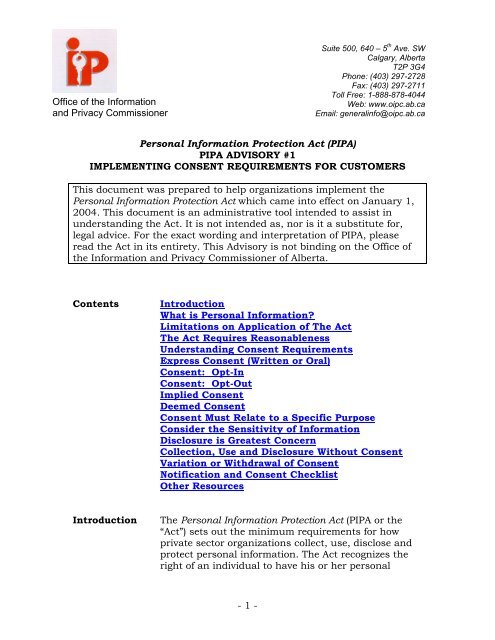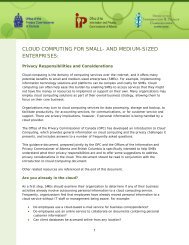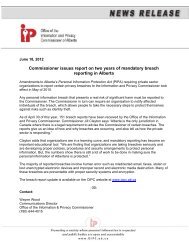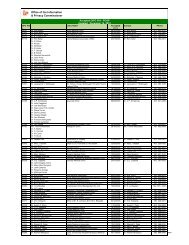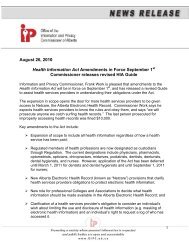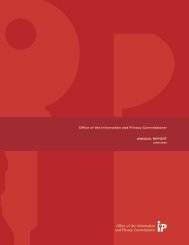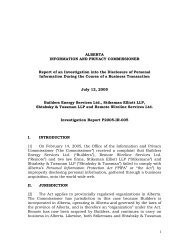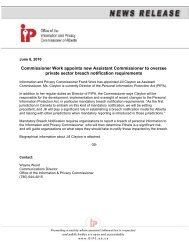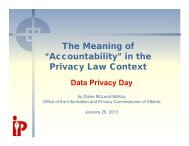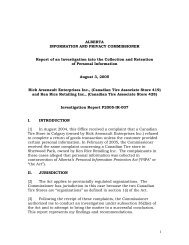PIPA - Office of the Information and Privacy Commissioner of
PIPA - Office of the Information and Privacy Commissioner of
PIPA - Office of the Information and Privacy Commissioner of
You also want an ePaper? Increase the reach of your titles
YUMPU automatically turns print PDFs into web optimized ePapers that Google loves.
<strong>Office</strong> <strong>of</strong> <strong>the</strong> <strong>Information</strong><br />
<strong>and</strong> <strong>Privacy</strong> <strong>Commissioner</strong><br />
Suite 500, 640 – 5 th Ave. SW<br />
Calgary, Alberta<br />
T2P 3G4<br />
Phone: (403) 297-2728<br />
Fax: (403) 297-2711<br />
Toll Free: 1-888-878-4044<br />
Web: www.oipc.ab.ca<br />
Email: generalinfo@oipc.ab.ca<br />
Personal <strong>Information</strong> Protection Act (<strong>PIPA</strong>)<br />
<strong>PIPA</strong> ADVISORY #1<br />
IMPLEMENTING CONSENT REQUIREMENTS FOR CUSTOMERS<br />
This document was prepared to help organizations implement <strong>the</strong><br />
Personal <strong>Information</strong> Protection Act which came into effect on January 1,<br />
2004. This document is an administrative tool intended to assist in<br />
underst<strong>and</strong>ing <strong>the</strong> Act. It is not intended as, nor is it a substitute for,<br />
legal advice. For <strong>the</strong> exact wording <strong>and</strong> interpretation <strong>of</strong> <strong>PIPA</strong>, please<br />
read <strong>the</strong> Act in its entirety. This Advisory is not binding on <strong>the</strong> <strong>Office</strong> <strong>of</strong><br />
<strong>the</strong> <strong>Information</strong> <strong>and</strong> <strong>Privacy</strong> <strong>Commissioner</strong> <strong>of</strong> Alberta.<br />
Contents Introduction<br />
What is Personal <strong>Information</strong>?<br />
Limitations on Application <strong>of</strong> The Act<br />
The Act Requires Reasonableness<br />
Underst<strong>and</strong>ing Consent Requirements<br />
Express Consent (Written or Oral)<br />
Consent: Opt-In<br />
Consent: Opt-Out<br />
Implied Consent<br />
Deemed Consent<br />
Consent Must Relate to a Specific Purpose<br />
Consider <strong>the</strong> Sensitivity <strong>of</strong> <strong>Information</strong><br />
Disclosure is Greatest Concern<br />
Collection, Use <strong>and</strong> Disclosure Without Consent<br />
Variation or Withdrawal <strong>of</strong> Consent<br />
Notification <strong>and</strong> Consent Checklist<br />
O<strong>the</strong>r Resources<br />
Introduction The Personal <strong>Information</strong> Protection Act (<strong>PIPA</strong> or <strong>the</strong><br />
“Act”) sets out <strong>the</strong> minimum requirements for how<br />
private sector organizations collect, use, disclose <strong>and</strong><br />
protect personal information. The Act recognizes <strong>the</strong><br />
right <strong>of</strong> an individual to have his or her personal<br />
- 1 -
information protected, <strong>and</strong> <strong>the</strong> need <strong>of</strong> organizations to<br />
collect, use or disclose personal information for<br />
reasonable purposes.<br />
Except where <strong>the</strong> Act says o<strong>the</strong>rwise, organizations<br />
must get consent to:<br />
• collect personal information,<br />
• collect personal information from someone who is<br />
not <strong>the</strong> individual,<br />
• use personal information, or<br />
• disclose personal information.<br />
NOTE: Personal employee information receives<br />
special treatment under <strong>the</strong> Act. For more<br />
information, see sections 15, 18 <strong>and</strong> 21 <strong>of</strong> <strong>the</strong> Act.<br />
What is Personal Personal information is any information, recorded or<br />
<strong>Information</strong>? not, for an identifiable individual. It includes, for<br />
example:<br />
• name, home address, age, weight, height, gender<br />
• employment or financial history<br />
• ID numbers, place <strong>of</strong> birth, ethnic origin<br />
• opinions, evaluations, or comments about an<br />
individual<br />
The Act does not apply where it is not possible to<br />
identify a specific individual from <strong>the</strong> information.<br />
Example: An organization could ga<strong>the</strong>r information<br />
from thous<strong>and</strong>s <strong>of</strong> customers about what <strong>the</strong>y buy,<br />
whe<strong>the</strong>r price is important, <strong>the</strong>ir gender, etc., as long<br />
as <strong>the</strong> data did not include <strong>the</strong>ir name or anything<br />
that could, for example, track <strong>the</strong>m to <strong>the</strong>ir mailing or<br />
e-mail address.<br />
TIP: Organizations should be careful when trying to<br />
determine if information is anonymous as <strong>the</strong>y may<br />
not be aware <strong>of</strong> how <strong>the</strong> information could be<br />
matched to an identifiable individual (for example, by<br />
combining it with information from more than one<br />
source).<br />
- 2 -
Limitations on Not all personal information is covered by <strong>the</strong> Act. For<br />
Application <strong>of</strong> example, <strong>the</strong> Act does not apply to business contact<br />
The Act information where it is collected, used or disclosed<br />
solely for <strong>the</strong> purpose <strong>of</strong> contacting an individual in his<br />
or her business capacity. Business contact information<br />
is defined in <strong>the</strong> Act to mean an individual’s name,<br />
position name or title, business telephone number or<br />
address, e-mail, fax number, <strong>and</strong> o<strong>the</strong>r similar<br />
business information.<br />
NOTE: Consent is required when business contact<br />
information is collected, used or disclosed for any<br />
o<strong>the</strong>r reason, unless <strong>the</strong> Act provides an exception.<br />
O<strong>the</strong>r examples <strong>of</strong> personal information which are not<br />
governed by <strong>PIPA</strong> are listed in Section 4(3) <strong>of</strong> <strong>the</strong> Act<br />
<strong>and</strong> include personal information:<br />
• in <strong>the</strong> custody or control <strong>of</strong> public bodies or<br />
governed by <strong>the</strong> Freedom <strong>of</strong> <strong>Information</strong> <strong>and</strong><br />
Protection <strong>of</strong> <strong>Privacy</strong> Act in Alberta;<br />
• as defined in Alberta’s Health <strong>Information</strong> Act, when<br />
collected, used or disclosed for health care<br />
purposes;<br />
• collected, used or disclosed solely for personal or<br />
domestic (home <strong>and</strong> family) purposes;<br />
• collected, used or disclosed solely for artistic,<br />
literary or journalistic purposes;<br />
• about an individual who has been dead for at least<br />
20 years or contained in a record that came into<br />
existence at least 100 years ago; or<br />
• contained in a court file, or in records <strong>of</strong> a Master,<br />
Judge or Justice <strong>of</strong> a Court <strong>of</strong> Alberta in compliance<br />
with <strong>the</strong> criteria set by <strong>the</strong> Act.<br />
The Act Requires The Act requires organizations to collect, use <strong>and</strong><br />
Reasonableness disclose personal information for reasonable purposes<br />
only. Moreover, a consent provided by an individual is<br />
only valid if it was reasonable in <strong>the</strong> circumstances.<br />
The test for reasonableness is what a reasonable<br />
person would consider appropriate in <strong>the</strong><br />
circumstances.<br />
TIP: It can be difficult for an organization to<br />
determine what a “reasonable person would consider<br />
- 3 -
appropriate in <strong>the</strong> circumstances.” What one person<br />
considers reasonable may be unreasonable to<br />
ano<strong>the</strong>r. It may be helpful to ask questions, such as:<br />
• Would I want this type <strong>of</strong> personal information<br />
about myself or my family collected, used or<br />
disclosed this way? If not, <strong>the</strong> practice may not be<br />
reasonable.<br />
• Have I confirmed that <strong>the</strong> majority <strong>of</strong> stakeholders<br />
(customers, potential customers) think <strong>the</strong><br />
collection, use or disclosure is reasonable in <strong>the</strong><br />
circumstances? If, for example, <strong>the</strong> majority <strong>of</strong><br />
employees did not think a particular use was<br />
reasonable, <strong>the</strong>n <strong>the</strong> organization might want to<br />
consider alternatives.<br />
• Would collection, use or disclosure <strong>of</strong> this type <strong>of</strong><br />
personal information benefit, or be detrimental<br />
to:<br />
- <strong>the</strong> stakeholder (customer, potential<br />
customer)?<br />
- <strong>the</strong> organization?<br />
- <strong>the</strong> general public/society?<br />
If, for example, a disclosure benefits <strong>the</strong><br />
organization but is detrimental to <strong>the</strong> stakeholder<br />
it is less likely to be considered reasonable than if<br />
it clearly benefits <strong>the</strong> stakeholder.<br />
Organizations must not mislead individuals about why<br />
<strong>the</strong>y are collecting, using, or disclosing personal<br />
information. Consent is not valid if it was obtained<br />
using false or misleading information, or by using<br />
deceptive or misleading practices.<br />
Example: An organization operates an Internet<br />
website which assists people who are interested in<br />
dating. The organization asks individuals for consent<br />
to collect <strong>the</strong>ir personal information to give to o<strong>the</strong>r<br />
singles who might be interested in meeting <strong>the</strong>m. In<br />
addition to providing dating services, <strong>the</strong> organization<br />
sells <strong>the</strong> contact information to ano<strong>the</strong>r organization<br />
to use in marketing romantic products. In this<br />
situation, consent for marketing was obtained by<br />
deception <strong>and</strong> is not valid.<br />
- 4 -
Underst<strong>and</strong>ing Organizations can only collect, use, or disclose<br />
Consent personal information as permitted or required by law<br />
Requirements or with <strong>the</strong> consent <strong>of</strong> <strong>the</strong> individual to whom <strong>the</strong><br />
personal information relates.<br />
Personal information must be collected directly from<br />
<strong>the</strong> individual, unless <strong>the</strong> individual consents to<br />
collection from o<strong>the</strong>r sources.<br />
An organization can not, as a condition <strong>of</strong> providing a<br />
service, require an individual to consent to <strong>the</strong><br />
collection, use or disclosure <strong>of</strong> information beyond<br />
what is necessary to provide <strong>the</strong> service.<br />
TIP: Organizations must limit <strong>the</strong>ir collection to<br />
information that is necessary to provide <strong>the</strong> service.<br />
This is particularly important where <strong>the</strong> organization<br />
wishes to rely upon an “implied” consent through<br />
“voluntary” provision <strong>of</strong> <strong>the</strong> personal information (see<br />
discussion <strong>of</strong> implied consent below). Implied consent<br />
can only apply to information directly required for <strong>the</strong><br />
purposes identified before or at <strong>the</strong> time <strong>of</strong> collection,<br />
or where information is voluntarily provided for selfevident<br />
purposes.<br />
Consent must be obtained before or at <strong>the</strong> time <strong>of</strong><br />
collection, except when inappropriate (for example, in<br />
an emergency). The form <strong>of</strong> consent must be<br />
appropriate to <strong>the</strong> kind or sensitivity <strong>of</strong> <strong>the</strong><br />
information.<br />
Upon reasonable notice, individuals may withdraw or<br />
vary <strong>the</strong>ir consent, subject to reasonable terms,<br />
conditions or qualifications.<br />
If organizations want to use personal information that<br />
was collected for one purpose for ano<strong>the</strong>r, secondary<br />
purpose, <strong>the</strong>y must obtain consent for <strong>the</strong> secondary<br />
use.<br />
Consent can take different forms including express,<br />
implied, or deemed.<br />
- 5 -
Express Consent Express consent is <strong>the</strong> most explicit method <strong>of</strong><br />
(Written or Oral) obtaining consent. It may be provided orally or in<br />
writing (including electronically), <strong>and</strong> occurs when an<br />
individual specifically agrees to collection, use or<br />
disclosure <strong>of</strong> personal information for specified<br />
purposes.<br />
Example: While shopping at your favorite drug store,<br />
you are asked if you wish to join <strong>the</strong>ir loyalty program<br />
which provides benefits based on your purchases.<br />
You agree <strong>and</strong> fill out <strong>the</strong> application form, signing<br />
<strong>the</strong> consent indicating that you agree to <strong>the</strong> drug<br />
store collecting <strong>and</strong> using your personal information<br />
for <strong>the</strong> purposes identified in <strong>the</strong> application, <strong>and</strong><br />
limiting disclosure to related companies identified on<br />
<strong>the</strong> form.<br />
Organizations will most likely comply with <strong>the</strong> Act’s<br />
consent requirements if <strong>the</strong>y obtain express, written,<br />
consent. However, oral express consent is also valid<br />
under <strong>the</strong> Act.<br />
Example: You call for a pizza to be delivered <strong>and</strong> are<br />
asked if <strong>the</strong> restaurant can collect your telephone<br />
number, address <strong>and</strong> pizza choice to be entered into a<br />
database so that <strong>the</strong> next time you call <strong>the</strong>y can<br />
quickly identify you <strong>and</strong> your preferences. You say<br />
“yes.”<br />
Oral consent may be appropriate where <strong>the</strong> consent is<br />
easily withdrawn <strong>and</strong> <strong>the</strong> implications are minor - for<br />
example, where <strong>the</strong> organization can easily delete<br />
information from a database if challenged about<br />
whe<strong>the</strong>r consent was properly obtained, <strong>and</strong> if <strong>the</strong><br />
information has not been disclosed to any o<strong>the</strong>r<br />
organizations.<br />
TIP: Organizations should establish a procedure to<br />
record oral consent. Where <strong>the</strong> consent relates to<br />
something likely to be important to ei<strong>the</strong>r <strong>the</strong><br />
individual or <strong>the</strong> organization, <strong>the</strong> procedure for<br />
recording must be <strong>of</strong> a high st<strong>and</strong>ard. If it may be<br />
important to have pro<strong>of</strong> <strong>of</strong> consent, organizations may<br />
decide written consent is more appropriate. This can<br />
be obtained in person, by mail, fax or even e-mail.<br />
- 6 -
When relying on oral consent, organizations should<br />
ensure training or o<strong>the</strong>r systems are in place so that<br />
<strong>the</strong> request for consent is always given in a consistent<br />
manner.<br />
Consent: The Act allows for express consent to be ei<strong>the</strong>r opt-in<br />
Opt-In or opt-out. Opt-in consent occurs when an individual<br />
specifically agrees to <strong>the</strong> collection, use or disclosure.<br />
Example: In <strong>the</strong> previous drug store example, <strong>the</strong><br />
application form includes an option to receive notices<br />
<strong>of</strong> up-coming sales. Individuals check a box<br />
indicating that <strong>the</strong>y wish to receive notices. (‘Opt-In”)<br />
Consent: Opt-out consent occurs when an organization<br />
Opt-Out indicates that it will collect, use or disclose<br />
information unless <strong>the</strong> individual indicates o<strong>the</strong>rwise.<br />
Example: In <strong>the</strong> previous drug store example, <strong>the</strong><br />
application form indicates that <strong>the</strong> drug store will<br />
assume individuals wish to receive promotional<br />
material from related companies unless <strong>the</strong>y check<br />
<strong>the</strong> box which indicates “no” or call a 1-800 phone<br />
number to advise that <strong>the</strong>y do not wish to be<br />
included. (‘Opt-Out”)<br />
If relying on opt-out consent, organizations must take<br />
into account <strong>the</strong> sensitivity <strong>of</strong> <strong>the</strong> information <strong>and</strong> <strong>the</strong><br />
intrusiveness <strong>of</strong> <strong>the</strong> use. Where <strong>the</strong> personal<br />
information involved is sensitive (for example, medical<br />
or financial information) organizations would be welladvised<br />
to obtain express (written or opt-in) consent.<br />
If relying on opt-out consent, organizations must<br />
advise <strong>the</strong> individual <strong>of</strong> <strong>the</strong> purposes for which <strong>the</strong><br />
information is being collected, used <strong>and</strong> disclosed, <strong>and</strong><br />
provide a reasonable period <strong>of</strong> time for <strong>the</strong> individual<br />
to decline or object.<br />
- 7 -
TIP: Opt-out consent may result in negative<br />
customer relations if used inappropriately. In <strong>the</strong><br />
drug store example, it is in <strong>the</strong> interest <strong>of</strong> <strong>the</strong><br />
organization to promote sales <strong>of</strong> products <strong>of</strong> related<br />
companies. Some customers may find <strong>the</strong> information<br />
useful; o<strong>the</strong>rs may be annoyed by unwanted<br />
solicitation.<br />
Do not make it difficult or troublesome for individuals<br />
to opt-out.<br />
If an organization tested a form with customers <strong>and</strong><br />
<strong>the</strong> majority willingly provided consent to a secondary<br />
use <strong>of</strong> non-sensitive information, it may be<br />
appropriate to use opt-out consent.<br />
Implied Consent The Act provides for consent to be implied when an<br />
organization informs individuals <strong>of</strong> <strong>the</strong> purpose for<br />
which <strong>the</strong> personal information will be used (or <strong>the</strong><br />
purpose is self-evident), <strong>and</strong> <strong>the</strong> individual voluntarily<br />
provides <strong>the</strong> information. It must also be reasonable<br />
for <strong>the</strong> individual to provide <strong>the</strong> information for that<br />
particular purpose.<br />
Example: You are shopping at <strong>the</strong> mall <strong>and</strong> <strong>the</strong>re is<br />
a digital camera on display at a store <strong>of</strong>fering film<br />
processing. The camera will be awarded to <strong>the</strong> lucky<br />
person whose name is drawn from <strong>the</strong> entries. You<br />
fill out <strong>the</strong> slip <strong>of</strong> paper with your name <strong>and</strong> phone<br />
number <strong>and</strong> drop it in <strong>the</strong> entry box.<br />
In this example, you have voluntarily provided<br />
personal information for <strong>the</strong> self-evident <strong>and</strong><br />
reasonable purpose <strong>of</strong> being contacted if you win.<br />
It would not be reasonable, however, for <strong>the</strong><br />
organization to use <strong>the</strong> information for o<strong>the</strong>r<br />
purposes such as creating a mailing list or being<br />
contacted by phone to promote services. These<br />
purposes were not stated on <strong>the</strong> entry slip, <strong>and</strong> would<br />
not be self-evident.<br />
- 8 -
Deemed Consent Personal information collected before <strong>the</strong> Act came into<br />
effect on January 1, 2004, is deemed to have been<br />
collected with consent, <strong>and</strong> may be used <strong>and</strong> disclosed<br />
for <strong>the</strong> purposes for which it was originally collected.<br />
Example: An individual provides <strong>the</strong>ir name <strong>and</strong><br />
mailing address to an organization prior to 2004 in<br />
order to receive a catalogue; after January 1, 2004,<br />
<strong>the</strong> organization may continue to use <strong>the</strong> information<br />
to send out catalogues. If <strong>the</strong> organization now wants<br />
to use <strong>the</strong> contact information for a new purpose,<br />
however, consent will be required.<br />
If <strong>the</strong> individual provided personal information in<br />
order to receive <strong>the</strong> catalogue, <strong>and</strong> has also been<br />
receiving marketing material from related companies<br />
since that time, <strong>the</strong> organization should now obtain<br />
<strong>the</strong> individual’s consent to disclose <strong>the</strong> information to<br />
<strong>the</strong> o<strong>the</strong>r organizations.<br />
Consent Must In order for an individual to provide a reasonable<br />
Relate to a consent to a proposed collection, use or disclosure <strong>of</strong><br />
Specific Purpose personal information, <strong>the</strong> individual must be notified<br />
<strong>of</strong>:<br />
• <strong>the</strong> purpose(s) for which <strong>the</strong> organization is<br />
collecting, using <strong>and</strong> disclosing <strong>the</strong> information,<br />
<strong>and</strong><br />
• <strong>the</strong> name <strong>of</strong> someone who is able to answer <strong>the</strong><br />
individual’s questions about <strong>the</strong> collection.<br />
Notification must occur before or at <strong>the</strong> time <strong>of</strong><br />
collection.<br />
Example: A pr<strong>of</strong>essional association notifies its<br />
members <strong>and</strong> potential members that it collects<br />
personal information about <strong>the</strong>m in order to inform<br />
<strong>the</strong>m about activities <strong>of</strong> <strong>the</strong> association, communicate<br />
with <strong>the</strong>m, mail a newsletter, fur<strong>the</strong>r <strong>the</strong> goals <strong>of</strong> its<br />
members, <strong>and</strong> collect annual fees for membership.<br />
The association tells <strong>the</strong>m that it will not disclose<br />
personal information to anyone outside <strong>the</strong><br />
association, except as permitted or required by law.<br />
The association fur<strong>the</strong>r states it will not sell, lease, or<br />
barter personal information.<br />
- 9 -
By filling in <strong>the</strong> membership application, which<br />
includes this notification <strong>and</strong> consent form, each<br />
member consents to <strong>the</strong> association collecting <strong>and</strong><br />
using <strong>the</strong> personal information for <strong>the</strong> identified<br />
purposes.<br />
Note: <strong>the</strong> association does not need consent to<br />
disclose personal information “as permitted or<br />
required by law” but, by mentioning this exception in<br />
<strong>the</strong>ir notification, <strong>the</strong> association has informed <strong>the</strong><br />
members <strong>of</strong> this possibility which may help to reduce<br />
concerns in future.<br />
TIP: Organizations need to clearly underst<strong>and</strong> <strong>the</strong><br />
purposes for which <strong>the</strong>y collect, use or disclose<br />
information in order to properly notify <strong>the</strong> individual<br />
when seeking consent. Consent will be valid only if it<br />
relates directly to <strong>the</strong> identified purposes, <strong>and</strong> is<br />
reasonable in <strong>the</strong> circumstances. If <strong>the</strong> notification <strong>of</strong><br />
purpose is too narrow, it may not comply with <strong>the</strong><br />
requirements <strong>of</strong> <strong>the</strong> Act; if it is too broad, it may be<br />
ei<strong>the</strong>r meaningless or deceptive.<br />
Merely notifying individuals that collection is taking<br />
place does not meet <strong>the</strong> requirements for notification<br />
under <strong>the</strong> Act, <strong>and</strong> <strong>the</strong>refore cannot be <strong>the</strong> foundation<br />
for a valid consent.<br />
Example: A business posts a notice that premises<br />
are under video surveillance. While customers <strong>and</strong><br />
o<strong>the</strong>rs are aware that collection is taking place, <strong>the</strong>re<br />
is no notification <strong>of</strong> <strong>the</strong> purpose(s) for collection, use<br />
<strong>and</strong> disclosure, nor is it “self-evident.” Accordingly<br />
<strong>the</strong>re is no consent for collection, use or disclosure.<br />
In this situation, <strong>the</strong> organization may want to state<br />
<strong>the</strong> purposes <strong>of</strong> collection, use <strong>and</strong> disclosure in <strong>the</strong><br />
notice, <strong>and</strong> provide <strong>the</strong> name <strong>of</strong> someone who can be<br />
contacted in <strong>the</strong> event individuals have questions<br />
about <strong>the</strong> surveillance. Even so, <strong>the</strong> organization<br />
must still establish that <strong>the</strong> surveillance activity is<br />
reasonable in <strong>the</strong> circumstances.<br />
- 10 -
Consider <strong>the</strong> The more sensitive personal information is, <strong>the</strong> greater<br />
Sensitivity <strong>of</strong> <strong>the</strong> organization’s obligation to protect it from misuse.<br />
<strong>Information</strong> The following are some examples <strong>of</strong> personal<br />
information that may be considered to be sensitive:<br />
• genetic information, drug <strong>and</strong> alcohol test results<br />
<strong>and</strong> general medical information <strong>of</strong> all types<br />
• biometric information (fingerprints, retina scans,<br />
voice prints)<br />
• sexual orientation<br />
• political or party affiliations<br />
• philosophical beliefs, <strong>and</strong> religious associations<br />
• unique identifiers, including health card numbers,<br />
employee identifications <strong>and</strong> social insurance<br />
numbers<br />
• ethnic, cultural <strong>and</strong> racial information<br />
The sensitivity <strong>of</strong> o<strong>the</strong>r types <strong>of</strong> personal information<br />
may depend upon factors which are particular to <strong>the</strong><br />
individual or <strong>the</strong> context.<br />
Example: A subscriber list for a news magazine<br />
generally may not be considered sensitive personal<br />
information. However, a subscriber list for some<br />
special-interest magazines may be considered<br />
sensitive as it reveals information about <strong>the</strong><br />
subscriber. For example, if <strong>the</strong> magazine was<br />
generally subscribed to by wealthy collectors <strong>of</strong><br />
specialty items, or individuals <strong>of</strong> a particular religious<br />
persuasion.<br />
Example: Home addresses are <strong>of</strong>ten not recognized<br />
as sensitive information, but where <strong>the</strong> individual is<br />
at risk <strong>of</strong> domestic violence, <strong>the</strong>ft or stalking, <strong>the</strong><br />
information may be highly sensitive.<br />
Prudent organizations will identify all situations where<br />
<strong>the</strong>y are ga<strong>the</strong>ring sensitive information to ensure that<br />
<strong>the</strong> appropriate consents have been obtained, <strong>and</strong> that<br />
adequate procedures are in place to prevent misuse.<br />
- 11 -
TIP: Consider how much personal information could<br />
be revealed if it was misused. Consider also <strong>the</strong><br />
potential harm to <strong>the</strong> individual if <strong>the</strong> data was<br />
disclosed without authorization or to <strong>the</strong> wrong<br />
people. The level <strong>of</strong> sensitivity is higher where <strong>the</strong><br />
harm is potentially greater.<br />
Disclosure is Many individuals are less concerned about <strong>the</strong> way an<br />
Greatest organization will use <strong>the</strong>ir personal information, than<br />
Concern <strong>the</strong>y are about what information <strong>the</strong> organization may<br />
disclose to ano<strong>the</strong>r party.<br />
Example: An individual consults a debt counseling<br />
organization to obtain advice on a financial problem.<br />
The individual is comfortable with <strong>the</strong> counselor<br />
knowing details <strong>of</strong> his situation, but is concerned that<br />
o<strong>the</strong>r staff might also read <strong>the</strong> file. The individual is<br />
also concerned that his employer or a creditor might<br />
find out that he has financial difficulties.<br />
Note that disclosure in this context also includes<br />
inappropriate access to information by employees or<br />
contractors who have no “need to know” to perform<br />
<strong>the</strong>ir jobs.<br />
Whenever possible, organizations should obtain<br />
written consent from <strong>the</strong> individual to disclose<br />
information to an outside party. The consent should<br />
clearly identify <strong>the</strong> o<strong>the</strong>r parties (e.g. outsourced call<br />
centre) to which <strong>the</strong> information is disclosed. While<br />
organizations may want to keep <strong>the</strong> wording as broad<br />
as possible so <strong>the</strong>y do not have to ask for consent in<br />
future, individuals will be more comfortable with<br />
specific wording.<br />
Collection, Use The Act allows organizations to collect, use <strong>and</strong><br />
And Disclosure disclose personal information without consent in<br />
Without Consent limited circumstances. These are set out in Sections<br />
14, 17 <strong>and</strong> 20 <strong>of</strong> <strong>the</strong> Act, <strong>and</strong> include situations where<br />
organizations wish to repay or collect on a debt, where<br />
collection, use or disclosure is necessary for an<br />
investigation, or clearly in <strong>the</strong> interests <strong>of</strong> <strong>the</strong><br />
- 12 -
individual <strong>and</strong> consent cannot be obtained in a timely<br />
way.<br />
TIP: Organizations should become familiar with <strong>the</strong><br />
circumstances under which <strong>the</strong>y may collect, use <strong>and</strong><br />
disclose personal information without consent.<br />
Fur<strong>the</strong>r discussion <strong>and</strong> examples <strong>of</strong> each exception<br />
are set out in The Guide for Businesses <strong>and</strong><br />
Organizations on <strong>the</strong> Personal <strong>Information</strong> Protection<br />
Act which is available through <strong>the</strong> <strong>of</strong>fice or web sites<br />
<strong>of</strong> <strong>the</strong> <strong>Office</strong> <strong>of</strong> <strong>the</strong> <strong>Information</strong> <strong>and</strong> <strong>Privacy</strong><br />
<strong>Commissioner</strong> <strong>and</strong> <strong>Information</strong> Management, Access<br />
<strong>and</strong> <strong>Privacy</strong>, Alberta Government Services.<br />
Variation or An individual may change or withdraw consent with<br />
Withdrawal <strong>of</strong> reasonable notice to <strong>the</strong> organization as long as this<br />
Consent does not break a legal duty or promise between <strong>the</strong><br />
organization <strong>and</strong> <strong>the</strong> individual.<br />
Example: A customer who has purchased a<br />
television <strong>and</strong> extended warranty from a retail outlet<br />
decides that she no longer wishes to receive<br />
promotional material for o<strong>the</strong>r products. The<br />
customer advises <strong>the</strong> retail outlet that consent for<br />
promotional mailings has been withdrawn. The<br />
organization must remove her name from <strong>the</strong> mailout<br />
list within a reasonable time.<br />
NOTE: In this example, <strong>the</strong> customer’s consent to<br />
use her personal information to honor <strong>the</strong> extended<br />
warranty is still in effect. While <strong>the</strong> organization must<br />
remove her name from <strong>the</strong> list for promotional<br />
mailings, it is reasonable to retain certain information<br />
in order to continue to honor <strong>the</strong> warranty.<br />
If <strong>the</strong> results <strong>of</strong> withdrawing or changing <strong>the</strong> consent<br />
are not immediately clear to <strong>the</strong> individual, <strong>the</strong><br />
organization must explain <strong>the</strong>m to <strong>the</strong> individual.<br />
Notification <strong>and</strong> Organizations may find it helpful to review <strong>the</strong><br />
Consent following checklist when establishing consent<br />
Checklist requirements under <strong>the</strong> Act.<br />
1. Is <strong>the</strong> information about an identifiable individual?<br />
If so, consent is required.<br />
- 13 -
2. If yes, is it personal information which is not<br />
covered by <strong>the</strong> Act (such as business contact<br />
information or information protected under <strong>the</strong><br />
Freedom <strong>of</strong> <strong>Information</strong> <strong>and</strong> Protection <strong>of</strong> <strong>Privacy</strong><br />
Act)?<br />
3. If it is personal information covered by <strong>the</strong> Act, can<br />
express (preferably written) consent be obtained for<br />
<strong>the</strong> collection, use <strong>and</strong> disclosure <strong>of</strong> <strong>the</strong> personal<br />
information?<br />
4. If it is personal information covered by <strong>the</strong> Act, has<br />
<strong>the</strong> individual volunteered <strong>the</strong> information in a way<br />
that implies consent for <strong>the</strong> organization to collect,<br />
use <strong>and</strong> disclose <strong>the</strong> personal information for<br />
reasonable purposes?<br />
5. If it is personal information covered by <strong>the</strong> Act, does<br />
<strong>the</strong> Act allow <strong>the</strong> organization to collect, use or<br />
disclose <strong>the</strong> information without consent?<br />
6. If consent is required from <strong>the</strong> individual, has <strong>the</strong><br />
organization clearly identified <strong>the</strong> purposes for<br />
which it collects, uses, <strong>and</strong> discloses <strong>the</strong><br />
information? Are <strong>the</strong>se purposes reasonable?<br />
7. Has <strong>the</strong> organization obtained <strong>the</strong> appropriate form<br />
<strong>of</strong> consent to collect, use <strong>and</strong> disclose <strong>the</strong> personal<br />
information?<br />
8. Has <strong>the</strong> organization obtained consent to collect<br />
personal information from a source o<strong>the</strong>r than <strong>the</strong><br />
individual? If so, can <strong>the</strong> organization confirm that<br />
consent to <strong>the</strong> o<strong>the</strong>r source so that <strong>the</strong>y know <strong>the</strong>y<br />
can release <strong>the</strong> information<br />
9. Has <strong>the</strong> organization developed appropriate<br />
procedures to obtain <strong>and</strong> record consents <strong>and</strong> to<br />
h<strong>and</strong>le withdrawal <strong>and</strong> variations <strong>of</strong> consents?<br />
10. Has <strong>the</strong> organization developed appropriate<br />
procedures to au<strong>the</strong>nticate <strong>the</strong> identity <strong>of</strong> <strong>the</strong><br />
individual giving consent to ensure it is actually <strong>the</strong><br />
individual about whom <strong>the</strong> personal information<br />
relates?<br />
- 14 -
TIP: When in doubt, assume consent is required<br />
unless <strong>the</strong>re are valid business reasons why obtaining<br />
consent is difficult or costly. If difficult or costly, take<br />
<strong>the</strong> time to determine whe<strong>the</strong>r <strong>the</strong> personal<br />
information is exempted under any specific<br />
provisions, or is outside <strong>the</strong> coverage <strong>of</strong> <strong>the</strong> Act. If<br />
consent is required, however, <strong>the</strong> organization must<br />
obtain it in spite <strong>of</strong> cost or difficulty.<br />
O<strong>the</strong>r Resources For an overview <strong>of</strong> <strong>the</strong> Act with examples <strong>and</strong> tips for<br />
incorporating good privacy practices, see A Guide for<br />
Businesses <strong>and</strong> Organizations on <strong>the</strong> Personal<br />
<strong>Information</strong> Protection Act.<br />
The Personal <strong>Information</strong> Protection Act, A Summary for<br />
Organizations summarizes <strong>the</strong> key obligations <strong>of</strong><br />
organizations.<br />
Getting Ready for <strong>PIPA</strong> is a quick reference for<br />
organizations preparing for <strong>the</strong> Act.<br />
Publications are available at <strong>the</strong> web site <strong>of</strong> <strong>the</strong> <strong>Office</strong><br />
<strong>of</strong> <strong>the</strong> <strong>Information</strong> <strong>and</strong> <strong>Privacy</strong> <strong>Commissioner</strong><br />
(www.oipc.ab.ca).<br />
Publications are also available on-line at <strong>the</strong> Alberta<br />
Government Services <strong>Information</strong> Management, Access<br />
<strong>and</strong> <strong>Privacy</strong> web site (www.psp.gov.ab.ca).<br />
Visit <strong>the</strong> Queen’s Printer web site to view an on-line<br />
version <strong>of</strong> <strong>the</strong> Act (www.qp.gov.ab.ca).<br />
- 15 -


